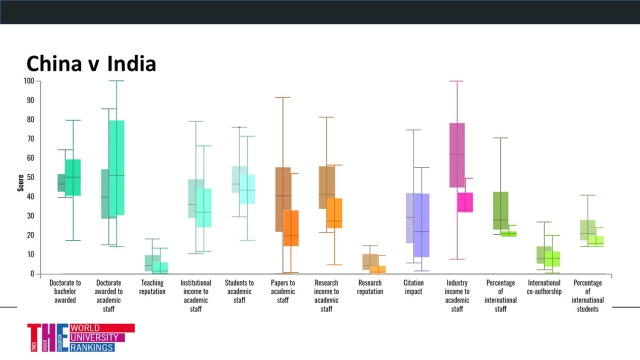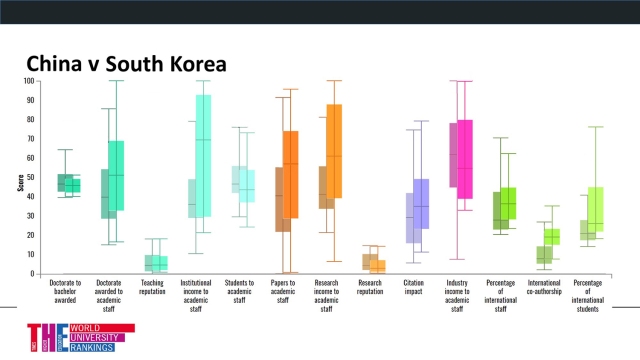In the past few weeks, we talked about higher education in Japan, South Korea, China, and India. Recently, THE DataPoints (Times Higher Education) provides a set of useful and interesting comparative data between China and three major Asian countries respectively: India, South Korea, and Japan.
Here is the news published on THE:
https://www.timeshighereducation.com/news/chinas-universities-significant-progress-more-do
The article reveals where Chinese universities are starting to outpace their rivals, as well as illustrating where China is still relatively lagging behind.
China VS India

The China-India chart shows that China has surpassed India on most measures. It can be attributed to several reasons:
- The higher HE investment of the Chinese government
- Successful and dynamic policies attracting its talents back home and international students studying in China
- The development of research collaborations between industry and academia
However, one metric proves a blog posted two weeks ago that India has a higher number of doctorates awarded than China.
China VS South Korea

The article gives a high rating to South Korea’s HE system. THE data scientist said that “South Korea was the shining example to any education ministry about how to improve their university sector.” There are two key aspects that China needs to catch up:
- The diversity of money sources – the government, industry, and student fees
- International collaboration – a key way to improve citation impact
However, although there is a gap between the two countries now, the article is optimistic about the future development of China’s higher education because of the outpouring of support from the Chinese government.
China VS Japan

I remember that Sho talked about the evolution of the balance between private and public funding in Japan’s HE. The China-Japan chart shows that Japan’s universities are behind both China and South Korea on the amount of income that universities are attracting from industry.
It is very interesting that Japan has a much higher staff-to-student ratio than China. However, the article claims that it is because of the collapse of the youth population in the country and it brings serious challenges for Japan to keep its leading role in Asia and globally.
Questions: Do you think that the data and metrics THE Data picked up reflect the real situation in your country? Why? Does this article present the future layout of Asian HE?
Thank you for sharing! Taking into account only the countries that you discuss in the blog post, China is clearly in the lead and if it continues on this trajectory, unless India deals with quality issues in higher education and Japan tackles its population challenges (which based on the class discussions, seems like a mammoth challenge that perhaps cannot be resolved in the medium term), the future outlay of higher education is aptly portrayed in the article.
As the article mentions, it true that it is challenging for Japanese universities to compete with the leading universities in the world. In order to keep or improve Japanese universities’ international position, they need to improve many points, such as industry collaboration and internationalization. I want to add one thing to the article about the students to academic staff ratio. Although the article says “it reflects the collapse in the youth population in the country,” it is suspicious because the data is mainly from the top universities that do not suffer from the population decline. Moreover, the Japanese government has encouraged universities to increase the students to academic staff ratio in the past several years since the top universes in the world, especially American universities, have good ratio. For your information, I attach the article about the student-to-staff ratio. https://www.timeshighereducation.com/student/news/top-100-universities-best-student-staff-ratio
Thank you Chaoyi for this informative post and for referring us to the article from Times Higher Education. I am intrigued by the fact that ‘South Korea also seems to have the edge over China on international collaboration – a key way to improve citation impact – suggesting that this is an area that Chinese universities must improve on in order to take their growth to the next level’.
It is interesting that South Korea is deemed to have a higher level of international collaboration than China, since we understand from our readings a few weeks ago that some Western universities are still hesitant to collaborate with them to build branch campuses in South Korea due to reasons such as finances and difficulty in attracting faculty members to live permanently in South Korea. Also, South Korea’s research is mostly written in Korean (presumably), and so it is surprising to me that it has a higher level of citational impact than China. I’m curious to know, why do you think Korea enjoys a higher level of citational impact than China? And how can China increase the levels of international co-authorship and international collaboration with HE institutions from other countries?
Thanks for your great question, Tim. It is shown that although China’s publication share in the world has been increasing exponentially, its impact defined as the number of citations per publication lags far behind. This state of affairs is expressed as a “quantitative expansion phase”. China’s science needs to move from the “quantitative expansion phase” in which it is nowadays to a “rising quality” phase. Correspondingly scientists’ motivation for publishing papers must shift from “driven by benefit” to “driven by excellence and timeliness”. Currently, China’s science although blending into the world is not yet a full player in its major league. Yet, all growth-related graphs show an exponential increase. Despite obvious problems and short-comings, the quality of Chinese research as a whole is increasing very quickly. I think if the necessary measures are taken and the observed exponentially increasing trend continues, the impact of Chinese research results will soon catch up with that of other major countries such as South Korea.
By the way, there is a new article published about how do universities use big data, related to what we discussed today.
https://www.timeshighereducation.com/features/how-do-universities-use-big-data